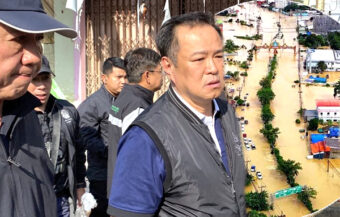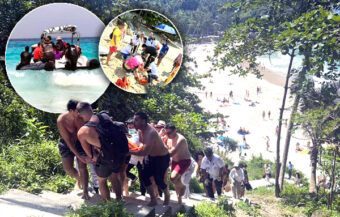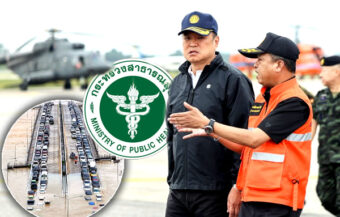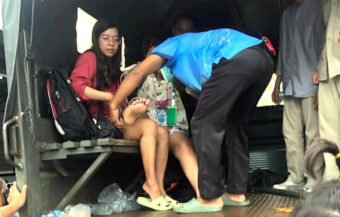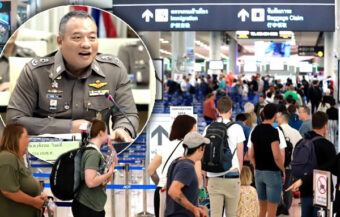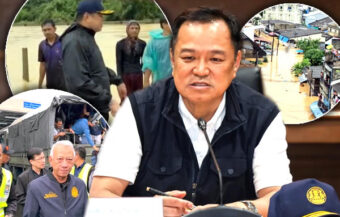Chaos erupts as Burmese troops flee into Thailand after KNLA base assault; over 100 soldiers surrender, hundreds of civilians displaced, and at least 30 killed in a brutal monastery airstrike as Myanmar’s military loses ground and war spills across borders.
Thailand’s Rajamanu Task Force sprang into action Saturday as chaos spilt across the border from war-torn Burma. Fierce clashes in Karen State sent waves of civilians fleeing into Tak Province — including up to 100 Burmese soldiers who laid down their arms and surrendered. The troops were quickly disarmed, treated for injuries and processed under international protocols. The flashpoint? A devastating strike by the Karen National Liberation Army (KNLA), which overran a junta-held base in eastern Myanmar. The assault marked another blow to a regime already reeling from losses on multiple fronts.
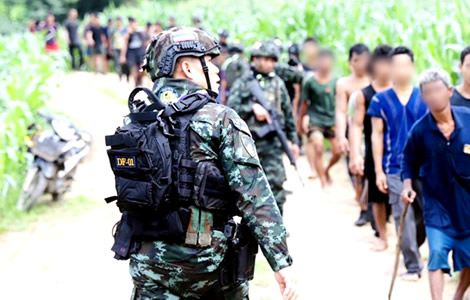
Meanwhile, horror unfolded farther north. Around 1 a.m. on Friday, July 11, a Burmese military jet bombed a Buddhist temple in Sagaing Region where civilians had taken shelter. At least 30 people — including children — were killed in the blast.
The attack has drawn sharp condemnation and further exposed the junta’s brutal tactics. Desperate and cornered, Myanmar’s military is now relying on airstrikes as it steadily loses ground to resistance forces loyal to the National Unity Government.
The message from the battlefield is clear: the junta is faltering, and its war is spilling over borders.
Phop Phra District, Tak Province, Thailand — On Saturday, July 12, 2015, the tense border region between Myanmar and Thailand witnessed a sharp escalation in conflict. The Karen National Liberation Army (KNLA), a prominent ethnic armed group, launched a sudden, coordinated attack on the Burmese military’s U-Kret Base.
KNLA assault forces Burmese troops to flee across Thai border after dramatic attack on U-Kret base
This base, located in Sukari District, Myawaddy District, Karen State, Myanmar, became the focus of fierce fighting that resulted in a significant withdrawal of Burmese troops.
The KNLA used drones to drop bombs on the base, surprising the defenders. Subsequently, ground forces closed in rapidly, overwhelming the Burmese soldiers stationed there. Although the military attempted to resist and requested reinforcements and additional weapons, their efforts failed. Consequently, nearly 100 soldiers abandoned the base and fled across the border into Thailand.
The fleeing soldiers crossed into Ban Waley Tai village, located in Tambon Waley, Phop Phra District, Tak Province. Thailand’s Rajamanu Task Force, part of the Naresuan Army, acted quickly. They took control of the situation, disarming the Burmese soldiers upon arrival. Furthermore, they inspected them for injuries, provided medical care, and offered humanitarian assistance.
Colonel Natthakorn Ruenthip, Commander of the Rajamanu Task Force, gave a detailed briefing at 4:40 p.m. on the day of the attack. He said the KNLA’s use of drones was pivotal. Not only did the bombs damage the base, but the sudden assault forced the Burmese soldiers into retreat. Although the soldiers called for support, the reinforcements never arrived in time. As a result, the base fell to the KNLA, and the Burmese troops fled.
Refugee surge hits Thailand as civilians and troops flee across the border from growing Myanmar violence
The situation triggered a wider displacement crisis. So far, 467 people, including civilians affected by ongoing violence, have fled Myanmar. These refugees crossed the border and are now in temporary safe areas within Phop Phra District.
Along with the military task force, local government officials, police and the Royal Thai Police cooperated to ensure the refugees’ safety. They provided essential aid such as food, water, shelter, and medical treatment. Notably, all assistance follows international humanitarian principles.
Meanwhile, the Rajamanu Task Force continues to strengthen border security. They have increased troop deployments and intensified patrols along vulnerable border areas. Moreover, additional weapons and equipment have been brought in.
These measures are part of a larger incident response plan designed to prevent incursions and protect Thailand’s sovereignty. The task force remains vigilant 24 hours a day, ready to respond to any new threats.
In addition to the nearly 100 Burmese soldiers who fled, 15 others surrendered to the Karen National Defence Force (KNDF). The Rajamanu Task Force has taken responsibility for processing these soldiers. They ensure these individuals are disarmed, medically treated and handled in accordance with legal and humanitarian standards.
Myanmar conflict escalates as opposition forces expand control and junta continues losing ground rapidly
This recent fighting marks yet another chapter in Myanmar’s ongoing internal conflict. Since the military seized power from the elected government in February 2021, the country has experienced escalating violence and political instability.
Many peaceful protesters were met with lethal force, leading to a surge in armed resistance. Various ethnic armed groups and newly formed People’s Defence Forces have taken up arms against the military regime. Consequently, many areas, especially in Karen State and Sagaing region, are battlegrounds for these violent clashes.
While the fighting at U-Kret Base grabbed attention today, another tragic event occurred nearby in Myanmar’s Sagaing region. On July 11, 2025, a Buddhist monastery in Lin Ta Lu village was struck by an airstrike.
The overnight attack killed at least 23 people, including four children. Approximately 30 others were injured, with ten in critical condition. These figures come from local resistance sources, but independent confirmation remains difficult due to restricted access.
Monastery bombing adds to civilian toll as Burmese air force targets shelters in ongoing military campaign
The monastery had become a refuge for over 150 civilians fleeing recent fighting. According to resistance group members who spoke anonymously, the attack occurred around 1 a.m. when a Myanmar military jet dropped a bomb on the compound. The regime has yet to officially comment on the incident. However, the military has historically denied targeting civilians and accused resistance forces of terrorism.
Reports from Myanmar’s independent media outlet, the Democratic Voice of Burma, suggest the death toll might be as high as 30. Still, verifying the exact numbers has proven challenging. The monastery attack is part of a broader military offensive aiming to regain control over resistance-held areas in Sagaing. This offensive involves tanks, fighter jets and various aircraft.
The Sagaing region has become a key stronghold for armed opposition groups. However, the resistance fighters lack effective air defence systems, making civilians especially vulnerable.
The military’s airstrikes on villages, towns and sanctuaries have caused widespread displacement. Thousands of people have been forced to flee their homes to avoid violence. Many have sought shelter in neighbouring towns such as Lin Ta Lu.
Regime aims to crush resistance before election as airstrikes rise and humanitarian crisis deepens further
Nay Phone Latt, spokesperson for Myanmar’s opposition National Unity Government, condemned the airstrike. He said the military regime is desperate to crush resistance before a planned general election later this year.
This election is widely seen as an attempt by the military to legitimise its seizure of power. Critics argue it is engineered to guarantee continued military control under a civilian facade.
Since the coup in early 2021, Myanmar’s civil war has intensified. Peaceful protests were met with deadly crackdowns, causing many citizens to take up arms. The military’s brutal campaign has escalated, especially against ethnic minorities and opposition strongholds.
The use of air power has increased significantly, often targeting civilian areas, schools and religious sites. Consequently, the humanitarian crisis worsens with every attack.
Thailand, sharing a long and porous border with Myanmar, faces ongoing challenges due to the conflict. Refugees crossing into Thailand strain local resources. Thai authorities, especially the Rajamanu Task Force and local police, remain on high alert. They have strengthened patrols to prevent border violations and maintain security.
Thai task force steps up patrols while border pressure mounts amid waves of refugees and junta retreat
The Rajamanu Task Force operates 24/7 to monitor the border and provide aid to refugees. They coordinate closely with government agencies, humanitarian groups, and local communities. Their efforts aim to balance security needs with humanitarian responsibilities.
Certainly, today’s events underline the absence of peace in the Myanmar-Thailand border region. The KNLA’s successful attack forced nearly 100 Burmese soldiers to flee into Thailand. Meanwhile, the ongoing military campaign in Sagaing has resulted in deadly airstrikes on civilian targets including a Buddhist monastery.
Peace breakthrough as Malaysian PM Anwar Ibrahim secures prisoner releases and new ceasefire in Burma
Ung Ing finally gives the order. Thailand pulls the plug on scam centre electricity in Burma. Cut at 9 am
Thailand’s response has been swift and measured. Security forces disarm fleeing soldiers and offer humanitarian assistance. Local officials continue caring for hundreds of displaced civilians seeking refuge. However, the situation remains fluid and unpredictable.
As the conflict persists, regional stability is increasingly at risk. The international community calls for dialogue and peaceful resolution. Yet, violence continues to disrupt lives and displace thousands. This is because of the determination of the military junta to enforce its will on a population in open rebellion. For now, the border between Myanmar and Thailand remains a critical flashpoint requiring constant vigilance.
Join the Thai News forum, follow Thai Examiner on Facebook here
Receive all our stories as they come out on Telegram here
Follow Thai Examiner here
Further reading:
High level diplomacy in Bangkok as Thaksin hosts Malaysian Premier and Burma’s reviled junta leader
Burma’s Min Aung Hlaing to meet Malaysia’s PM Anwar Ibrahim in Bangkok on Thursday in peace push
China closes border crossings with Burma after bomb attack on its consulate in Mandalay last week
Arakan Army on the verge of seizing Burma’s western Rakhine State as junta power collapses there
Burma’s General Min Aung Hlaing suffers more setbacks as his regime moves towards collapse
Ex-Senator gives PM Srettha 50:50 odds on surviving this Wednesday. Not impressed with his defence
Political maelstrom may be unleashed in June with potential crises brewing and coming to a climax






